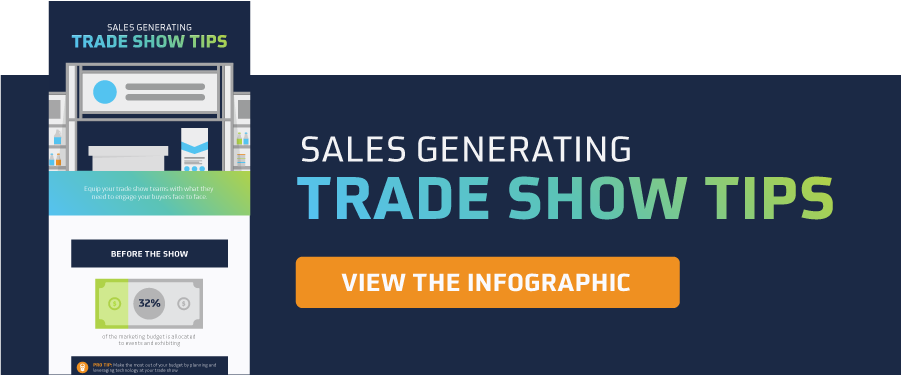Most of you have been to and participated in a trade show in the last year. Did you know 70% of trade show exhibitors don’t have specific objectives, even they may be spending an average of 31% of their marketing budget on them? Many of these trade shows reach a national audience and it’s up to you to make a good impression. Below are some tips to get the most out of your trade show marketing.
Before the Show
Even before the show starts it’s important to have a trade show marketing plan and be strategic about goals and communication.
Make specific goals/objectives
If you were running a regular marketing campaign you would make goals and objectives beforehand, right? The same thing goes for trade show marketing. After all, this is one of your largest marketing expenses and when done properly can bring in many qualified leads and a lower cost than outboard sales.
Start with benchmarks, understand what your objectives are and work backwards to figure out the leading indicators (smaller goals that add up to the larger goal) to getting there. (i.e. how many people do you need to talk to, to get a meeting set after the show)
There are many different types of trade show goals. Generally, we look at them in 3 different categories:
Awareness
These are goals that help spread the word about you in an industry, they are not backed up by specific lead metrics but often will lead to increase lead generation down the road. Here are a few examples:
- Establish a presence in a new industry
- Reinforce company position in the market
- Promote a specific brand message
- Introduce a new product
- Enter new market
Quantifiable
These types of goals relate back to the numbers, and in turn are quantifiable (hints the name) for example:
- Meeting with X number of people
- Identifying X number of distributors
- Selling X amount of Products
- Producing X number of leads or prospects
Logistical
This type of goal relates to what is happening on the floor during the show, these are things like:
- PR opportunities/Interviews
- Demo equipment products or solutions
- Generate booth traffic
- Promote excitement at your booth
It’s important to understand what you are trying to do at each trade show because this will help you determine the best associates to send to represent your company and achieve your goal.
Show selection if you are not sure what show to attend
When selecting shows to attend it’s important that you consider why you should be attending. “Because we go every year” really isn’t a good enough reason. You want to make sure you understand the audience for the shows, the alternatives, and the opportunities.
If you're thinking about exhibiting at a show for the first time consider a few things:
- Timing - What time of year does the show fall in? Can you devote the time you should to preparing or is it right in the middle of your busy season?
- Research - Does that show have a good history, are there many attendees and are those attendees in your target audience?
- Attend - It is often helpful if you simply attend the show before exhibiting, this may not always be feasible, but that will give you a true feel of the show before diving in head first with a booth.
- Marketing opportunities - Many shows have additional marketing opportunities to reach the audience. It’s good to understand these and take advantage of them when budget allows. It can be a great way to have another connection with the audience.
Tell people you are there
Did you know 76% of attendees use pre-show information to plan their time at a trade show? Attendees are trying to pack as much into each event as possible so it is important that you respect their time. Let target accounts know you will be attending the trade show and allow them to make an appointment with a representative to demo your new product or connect with a face-to-face meeting. Pre-show promotion with your “house list” and the show list can raise the quality of your booth traffic by 46%, similarly, it can rain the conversion of your booth visitor to lead up 50%.
Using a multiple touchpoints method can be effective for trade show marketing as well. This could include:
- Digital advertising and targeting
- Printed campaigns like direct mail
- Additions to outgoing communications like invoices, account statements or shipping notifications
- Advertising with the event in pre-show magazines or flyers
Think about what you should say in these communications. It's important to say why and attendee should visit you. Don’t just say “Visit us at booth number x” but say why. Why should the attendees take the time to visit you? Are you offering a show special? Launching a new product? What’s in it for them? Make sure your trade show marketing strategy gives them a good reason to take the action and let them know what that action should be.
At the Show
Know what you are promoting and hone your pitch
Make sure you have a consistent and concise message. Know what your Unique selling proposition (USP) is. Your USP should help solidify you in the market and give you something unique to talk about with your audience at the show. Keep in mind you may only have 30 seconds or so to hook someone in conversation. Be prepared with a couple sentences about your product. On the flip side know how to politely end the conversation if someone is not qualified.
Keep it interesting
Try to keep your booth and conversations interesting. Attendees have a lot of people to talk to at the show make sure your booth is one they can’t miss. Here are a few ideas:
- Video existing customers for an off-the-cuff testimonial to use in social media and to promote the show for the next year
- Promote a special offer
- Give promo pieces and prizes away
- Create an event or happy hour at your booth
- Multi-media and or video
- Track lead info using online forms so there is no need for pins, paper or manual entry into your CRM
Post Show
Even though the show is over, your job is not. It’s time to make the most of the leads you gathered at the event.
Follow-up
Not all leads should be treated the same. We would advise against just creating one blanket email to be sent to the entire list. Encourage your sales team to follow up individually with leads they connected with and tailor your messages for new clients vs. existing ones.
Track results
Can you believe just 47% of companies track trade show leads and events through the buying cycle? And only 28% measure and report the number of leads that ultimately convert to sales as part of their exhibit programs. If you are not tracking your sales through the process it can be hard to justify spending the money on the trade show the following year.
When done right, converting a trade show’s lead to a sale can costs 38% less than sales calls alone. For a refresher here is a link to a quick tips infographic that will be sure to send you on your way to trade show success!
Resources:
Exhibit Survey
CEIR commissioned a study by Deloitte & Touche exhibitors
https://graphicolor.com/blog/10-impressive-statistics-trade-show-marketing-program/
EXHIBITOR http://www.exhibitoronline.com/topics/article.asp?ID=742
CEIR: The Spend Decision: Analyzing How Exhibits Fit Into The Overall Marketing Budget
Subscribe to Our Blog
Stay up to date with the latest marketing, sales, and service tips.




